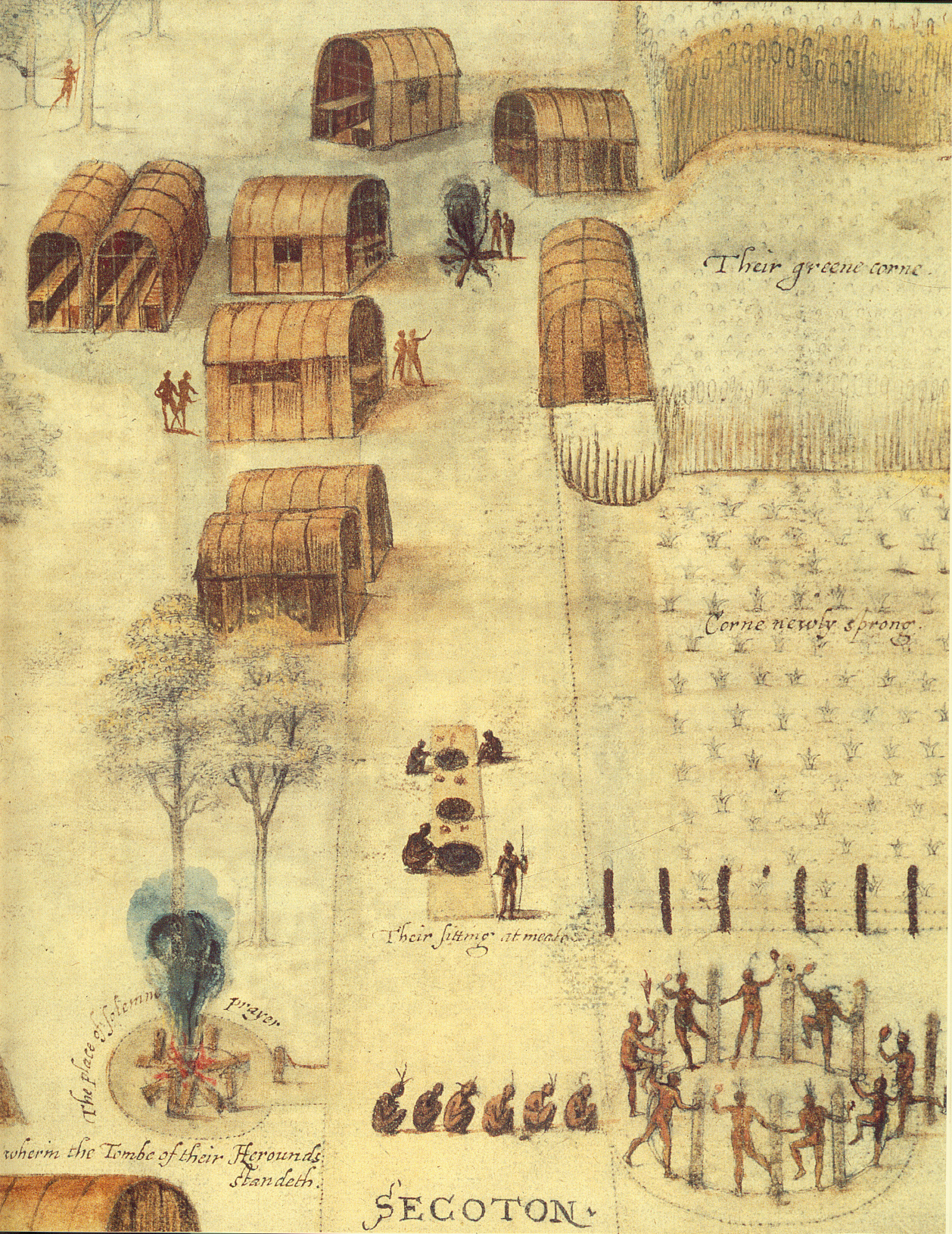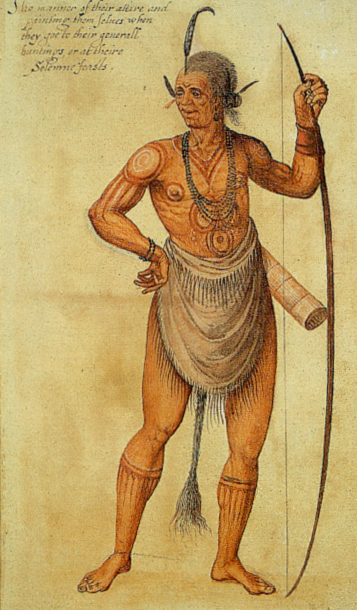Aquascogoc on:
[Wikipedia]
[Google]
[Amazon]

 The Aquascogoc is the name given to a Native American tribe of Secotan people and also the name of a village encountered by
The Aquascogoc is the name given to a Native American tribe of Secotan people and also the name of a village encountered by
Retrieved March 2011 During White's time at Roanoke Island, he completed numerous watercolor drawings of the surrounding landscape and native peoples. These works are significant as they are the most informative illustrations of a Native American society of the Eastern seaboard, and predate the first body of "discovery voyage art" created in the late 18th century by the artists who sailed with Captain
Miller, Lee, ''Roanoke: Solving the Mystery of the Lost Colony''
Retrieved April 2011 * Milton, Giles, ''Big Chief Elizabeth - How England's Adventurers Gambled and Won the New World'', Hodder & Stoughton, London (2000)
Aquascogoc at www.h-net.org
Retrieved April 2011
Retrieved April 2011
{{authority control Indigenous peoples of the Southeastern Woodlands Algonquian peoples Native American history of North Carolina Native American tribes in North Carolina

 The Aquascogoc is the name given to a Native American tribe of Secotan people and also the name of a village encountered by
The Aquascogoc is the name given to a Native American tribe of Secotan people and also the name of a village encountered by English
English usually refers to:
* English language
* English people
English may also refer to:
Peoples, culture, and language
* ''English'', an adjective for something of, from, or related to England
** English national ...
colonists during their late 16th century attempts to settle and establish permanent colonies in what is now North Carolina
North Carolina () is a U.S. state, state in the Southeastern United States, Southeastern region of the United States. The state is the List of U.S. states and territories by area, 28th largest and List of states and territories of the United ...
, known at the time as Virginia
Virginia, officially the Commonwealth of Virginia, is a state in the Mid-Atlantic and Southeastern regions of the United States, between the Atlantic Coast and the Appalachian Mountains. The geography and climate of the Commonwealth are ...
. Together with the rest of Secotan people they formed a part of the Native American group known as the Carolina Algonquian
Carolina may refer to:
Geography
* The Carolinas, the U.S. states of North and South Carolina
** North Carolina, a U.S. state
** South Carolina, a U.S. state
* Province of Carolina, a British province until 1712
* Carolina, Alabama, a town in t ...
Indians, and spoke the now extinct Carolina Algonquian language
Carolina Algonquian (also known as Pamlico, Croatoan) was an Algonquian language of the Eastern Algonquian subgroup formerly spoken in North Carolina, United States. Carolina Algonquian was formerly spoken by Secotan (later known as Machapunga) ...
. In 1585 the village of Aquascogoc was burned by Sir Richard Grenville, in retaliation for the alleged theft of a silver drinking vessel.
Roanoke colony
SirRichard Grenville
Sir Richard Grenville (15 June 1542 – 10 September 1591), also spelt Greynvile, Greeneville, and Greenfield, was an English privateer and explorer. Grenville was lord of the manors of Stowe, Cornwall and Bideford, Devon. He subsequently ...
was the leader of the 1585 expedition which first attempted to land English settlers on Roanoke island. Guided by Chief Manteo, Grenville arrived at the village but the inhabitants showed little inclination to meet with him, and the settlers soon returned to their boats. However, a silver drinking cup was found to be missing, and was believed to have been stolen by the Aquascogoc, leading to a furious reaction from Grenville. During the angry exchanges which followed, the village of Aquascogoc was torched on Grenville's orders.
The Aquascogoc would however have their revenge. Grenville left Roanoke, leaving behind fifteen men, who were all battle-hardened. When Governor John White returned in 1587 he searched for the fifteen, but found only bones. White quickly made contact with friendly natives led by Chief Manteo, who explained to him that the lost fifteen had been killed by hostile Secotan, Aquascogoc and Dasamongueponke warriors, choosing a time and place of attack "of great advantage to the savages".Milton, p.220
Legacy
Much of what is known about the lives of the Aquascogoc and other Algonquian tribes in 16th-centuryNorth Carolina
North Carolina () is a U.S. state, state in the Southeastern United States, Southeastern region of the United States. The state is the List of U.S. states and territories by area, 28th largest and List of states and territories of the United ...
survives because of the watercolor painting
Watercolor (American English) or watercolour (British English; see spelling differences), also ''aquarelle'' (; from Italian diminutive of Latin ''aqua'' "water"), is a painting method”Watercolor may be as old as art itself, going back to ...
s and the journal kept by Governor John White who was commissioned in 1585 to "draw to life" the inhabitants of the New World and their surroundings.Article in Smithsonian Magazine by Abigal Tucker, December 2008Retrieved March 2011 During White's time at Roanoke Island, he completed numerous watercolor drawings of the surrounding landscape and native peoples. These works are significant as they are the most informative illustrations of a Native American society of the Eastern seaboard, and predate the first body of "discovery voyage art" created in the late 18th century by the artists who sailed with Captain
James Cook
James Cook (7 November 1728 Old Style date: 27 October – 14 February 1779) was a British explorer, navigator, cartographer, and captain in the British Royal Navy, famous for his three voyages between 1768 and 1779 in the Pacific Ocean and ...
. They represent the sole surviving visual record of the native inhabitants of America, encountered by England's first settlers.
White's enthusiasm for watercolor paint was unusual; most contemporary painters preferred to use oil-based paints.Milton, p.199 White's watercolors would soon become a sensation in Europe, and it was not long before the paintings were engraved
Engraving is the practice of incising a design onto a hard, usually flat surface by cutting grooves into it with a burin. The result may be a decorated object in itself, as when silver, gold, steel, or glass are engraved, or may provide an i ...
by the Flemish master engraver Theodore de Bry
Theodor de Bry (also Theodorus de Bry) (152827 March 1598) was an engraver, goldsmith, editor and publisher, famous for his depictions of early European expeditions to the Americas. The Spanish Inquisition forced de Bry , a Protestant, to fle ...
.Milton, p.200 Through the medium of print, the illustrations became widely known and distributed; they were published in 1590 under the title "America".
See also
*Algonquian peoples
The Algonquian are one of the most populous and widespread North American native language groups. Historically, the peoples were prominent along the Atlantic Coast and into the interior along the Saint Lawrence River and around the Great Lakes. T ...
* Dasamongueponke
*Pamlico
The Pamlico (also ''Pampticough'', ''Pomouik'', ''Pomeiok'') were American Indians of North Carolina. They spoke an Algonquian language also known as ''Pamlico'' or ''Carolina Algonquian''.
Geography
The Pamlico Indians lived on the P ...
* Secotan
Notes
References
Miller, Lee, ''Roanoke: Solving the Mystery of the Lost Colony''
Retrieved April 2011 * Milton, Giles, ''Big Chief Elizabeth - How England's Adventurers Gambled and Won the New World'', Hodder & Stoughton, London (2000)
External links
Aquascogoc at www.h-net.org
Retrieved April 2011
Retrieved April 2011
{{authority control Indigenous peoples of the Southeastern Woodlands Algonquian peoples Native American history of North Carolina Native American tribes in North Carolina